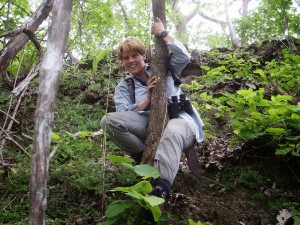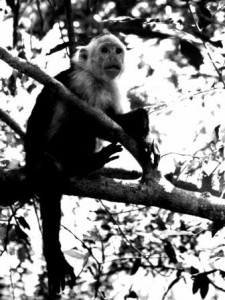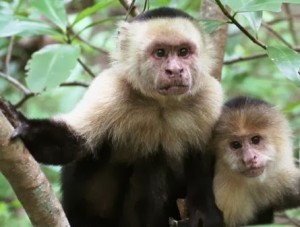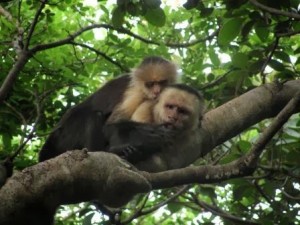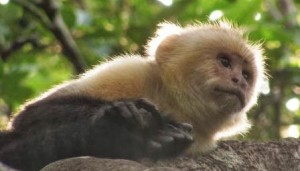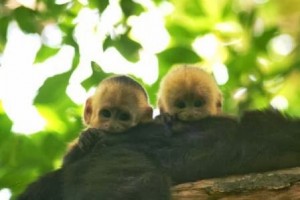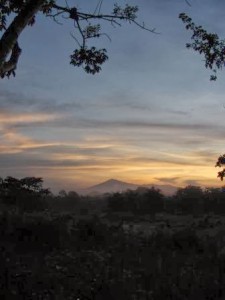Eight Years of Memories
The following post is from Wiebke Lammers, “monera suprema.” This year, Wiebke left us after a decade of service to the monkey project. She is currently a graduate student in the MSc program in Conservation and Biodiversity at University of Exeter. We miss her terribly but know that she will go on to do great things for conservation!
Here is her post. All other photos are taken by Wiebke Lammers.
My life with the Lomas Barbudal Monkey Project spans almost one decade.
I first moved to Costa Rica in 2003 to work for the project as a volunteer field assistant. After one year at the field site I continued my work for the project as the data analyst in Germany until 2006. That year I returned to Costa Rica taking over the management of the research station. The following seven years I worked as the project’s administrator on site. The memories that accumulated over that time are far too numerous for me to recreate them all here. I will try to share a few special stories that will hopefully help to illuminate why this species is of particular importance to me.
Over the years that I was involved in studying white-faced capuchin monkeys (Cebus capucinus) in the wild, I came to know hundreds of individuals more intimately than I knew my family and best friends. I knew where they woke up in the morning, where they went to bed at night and who they snuggled up with. I knew what they ate all day (that is literally every item they stuffed into their mouths and even how many times they ingested). I knew what their poo looked like and what it contained. I knew who they preferred as friends, who they liked to play with and what games they invented for their entertainment. I knew who they did not like and frequently fought with. And since nothing is sacred: I knew with whom, where, when and how they had sex. I was a monkey stalker par excellence! Thankfully my interest in investigating private lives in such details never stretched from our non-human cousins to my own species or I would have been in deep trouble.
Still, more importantly than recording confidential elements of simian life, my time with the monkeys allowed me to gain insight into their sophisticated and complex social group structures. The opportunity to see the world from their perspective and to try to understand their decision-making processes was an enlightening as well as a humbling experience. Being highly intelligent and gregarious creatures, the capuchin monkeys mastered communal living, negotiation and diplomacy sometimes more skilfully than their human observers did.
Capuchin society is built on collaboration. Every group has an alpha male and he is the boss, but without his allies and especially without the support from the females, he is not going to be dominant for a very long time. Cacique (nicknamed Cassie) learned this lesson in 2011. The picture below shows Cassie and Yasuni in a coalition against a common enemy. Their hair is on edge, which makes them look bigger, and both monkeys show their canines and frown. Most importantly for the coalition, Yasuni is climbing on top of Cassie, which makes them even more imposing. Cassie and Yasuni are half-brothers born into the same age cohort and have spent all their lives together. They make up a splendid team, but that does not mean they will not be opportunistic if there is something to gain.
In September 2011 Cassie and Yasuni managed to oust seven males from a neighbouring group. Cassie implemented himself as the new alpha male, and Yasuni was subordinate. The female were not in favour of the change and gave their new leader a rather tough start by constantly picking fights with him. Cassie actually was a socially acute monkey, but in this case he was unable to win the females’ affection. He got frustrated and started to push them out of the trees whenever one of them dared come too close. Consequently this just brought about more stress. During this state of social instability, Yasuni was able to strike up a friendship with Fantasma, one of the most reactive and fearless females of the group. Yasuni and Fantasma’s closeness, as well as Cassie’s rough take on leadership, caused more females to side with Yasuni. Not long after the two males had taken over the group, Yasuni was able to snatch the alpha position away from Cassie simply because he was more popular with the females. Cassie sulked for a while but the group dynamics soon stabilised. There was not really much Cassie could have done about it other than challenging Yasuni in a battle, and I think Cassie was wise enough not to risk the important relationship he enjoyed with his brother.
Lesson learned: be nice to your ladies!
There are hundreds of similar stories about male politics. Subtle changes in alliances would have a huge effect on male social bonds and subsequently group dynamics. Being the dominant male was a vulnerable position as aspiring young, maybe stronger males could challenge the alpha at any time. The dominant male always had to watch his back and needed to keep a few trusted allies close. Yet on many occasions it was exactly those associates that committed high treason, toppled the leader and took over the group. Every day had the potential of becoming a Shakespearean drama crossed with an episode of The Sopranos!
In white-faced capuchin society, the males migrate between social groups but females stay together all their lives and form extraordinarily strong matrilines. Mezcla was the highest ranking female in the social group Rambo where she was surrounded by her four adult daughters and a multitude of grandchildren. A fierce and meddlesome character, Mezcla was respected by everyone in the group. If one of her children was screaming in distress she would come charging in, making sure everything was alright. She once wrestled one of her juvenile daughters out of the coils of a boa constrictor! But Mezcla was not only tightly bonded with her female relatives. She enjoyed an exceptionally close relationship with the alpha male of her group, Pablo. While males and females usually do not spent much time in close proximity, Pablo and Mezcla were rarely seen apart. Where one went, the other would follow and the quality of their relationship was probably critical to the remarkably stable social dynamics and the low infant mortality that the group enjoyed over many years. Pablo disappeared in 2009, having been an alpha for over a decade. He had sired at least 25 children and had over 80 grandchildren and over 10 great grandchildren. He had enjoyed a long and very successful life.
Moth was the new alpha male. He actually grew up in Rambo’s group but never bothered to migrate anywhere else. Maybe there was less pressure to move, since he was not directly related to either Pablo or Mezcla. I always thought Moth was rather more concerned with eating than with politics until 2008 when he overthrew Pablo in the most gentle fight for dominance I had ever witnessed. Mezcla had known Moth since his birth, and up to 2009 it did not seem she was particularly fond of him. After Pablo’s death things seemed to change, and over the following years Moth and Mezcla became friends. By 2012 the two had regular cuddling sessions. It was a common sight to see them snuggle up, Mezcla embracing Moth who would gently nibble on her fingers, toes or tail. Obviously Mezcla had been able to set her initial resentment aside and establish another harmonious relationship with the alpha male. Mezcla died in 2012. She had been a bold and fearless female, a great leader and politician and even though I observed her for almost ten years, I feel I still do not quite grasp the whole extent of what made her so exceptional.
Another aspect that makes these monkeys fascinating is their engagement in alloparenting (babysitting). White-faced capuchins live in multi-male/ multi-female groups, and everyone helps looking after the infants. For the first two months, a newborn baby rides exclusively on the back of the mother, but as soon as its mobility is more secure it will start exploring the environment. From that moment, the infant starts to forge social relationships with everyone in the group. Adult males willingly provide transportation. The sight of the big alpha male proudly strutting about with a tiny infant on his back is a most engaging scene. Adult females will share milk with babies not their own. Both juvenile males and females are pretty baby-crazy and display a great deal of self-importance when they are in charge of the newborn. Even older infants, hardly bigger than a newborn themselves, try to carry babies on their backs, nearly collapsing under the weight. Infant development is slow and energy demanding. Females give birth to only one baby every two years. The Lomas Barbudal Monkey Project has only one record of twins, both of whom died in their first year of life. A high level of alloparenting increases the chances of raising offspring successfully.
One female who took alloparenting to a whole new level was Gerber (inadvertently very aptly named!). In 2008 Gerber gave birth to Ginseng. At the same time Darwin, another adult female in the group, gave birth to Rubén Darío. Everything was completely normal for the first couple of weeks, both females nurturing their babies and largely going their own ways. Gerber and Darwin were cousins, sharing the same maternal grandmother, but they never spent much social time together. It was never exactly clear what happened, but when the two infants were about three weeks old, Gerber somehow managed to get Rubén Darío on her back and from that moment on she cared for both of the babies. Darwin was a low ranking, nervous female who had been the victim of several fights on that day; maybe she had lost Rubén and Gerber wanted to help him. Maybe Gerber stole Rubén, but there was no indication that the two females had had any conflict. Darwin followed Gerber for a short while, unsuccessfully displaying a behaviour that invited the infant to crawl back on to her body. Gerber never showed aggression towards Darwin or stopped her from getting close. However she certainly did not seem to mind having two babies on her back. She took it as if it were the most natural thing in the world. When Darwin could not get Rubén back, she stopped trying and never put much effort into raising him afterwards. In the months that followed, Ginseng and Rubén thrived, making Gerber’s back seem like a very cramped place. She proved to be an expert mother with the patience of a saint and cared for both infants diligently. I am sure she was grateful once the two were old enough to hitch rides with babysitters so she could get a well-deserved break from being the group’s minivan.
Sadly, Ginseng disappeared when he was seven months old. Gerber continued to care of Rubén. He survived his first year of life and grew into a quirky, inquisitive little boy but unfortunately disappeared when he was 14 months old. Both babies could have been victims of natural predation. However, it is also possible that by having to share one mother, neither managed to get sufficient nutrition. Capuchin mothers usually do not raise two infants at the same time, and it may have given Ginseng and Rubén a significant disadvantage. In all of this, Gerber’s behaviour was the most puzzling. She adopted an infant that was not closely related to her. Genetic evidence suggested that Rubén Darío was the offspring of Gerber’s maternal cousin and her paternal half brother. She did not seem to share a sufficient amount of genes with him to warrant seriously weakening the survival chances of her own offspring. Her behaviour did not seem to make sense. However, mothers do not always go by a genetics textbook. Maybe it seemed like the right choice at the time and maybe Gerber thought she could do it. Maybe she did not think at all and just answered to a hardwired instinct that dictated an infant needed to be looked after. Whatever her incentives were, Gerber did do a very impressive job for as long as she could. She has since raised two more infants making her the proud mother of four. Darwin also has had two babies in the meantime, both of which she successfully raised herself.
I spent eight years of my life closely documenting the events in the lives of over three hundred monkeys. Individuals that were born in my first year at the site grew up to have their own babies. I watched how important friendships were forged or bonds were broken. Young males engaged in the dangerous endeavour of finding a new group. Some boys I first met as carefree juveniles are now responsible and successful alpha males. I also had to say farewell to a great many beloved individuals that died during these years. Because these monkeys have personalities and social relationships just as complex as our own, I cannot help but being drawn into their world and care about their well-being. They are my furry relatives with prehensile tails…!


